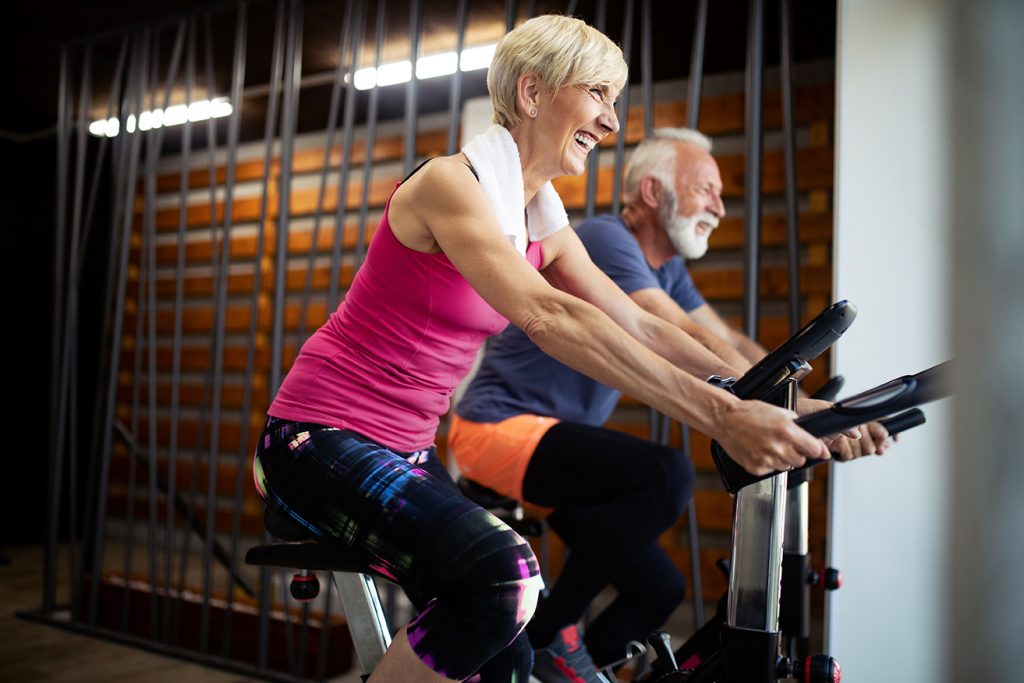Consistent exercise and physical activity may be the closest thing we have to the “fountain of youth” in our society today. Dr. Michael Roizen, author of The RealAge Workout, cites studies on identical twins that show genetic inheritance influences only about 30% of the rate and way one ages – the rest is up to you!

The amazing thing is that it is never too late to live younger through increased activity and it is essential that we age successfully. My challenge to you is to view your physical activity endeavors as one healthy decision at a time toward maintaining your capacity to live robustly and independently.
Let’s explore aging – it is not isolated but systemic; that is, it affects the whole body. Loss or disuse in one area is echoed in another area. Many of the negative changes that occur with aging are similar to those that accompany a sedentary lifestyle. Trying not to sit longer than 30 minutes at a time is a good rule of thumb. Older adults may experience these effects of aging without physical activity intervention: decreased aerobic power, anaerobic power and capacity; decreased muscular strength and power; decreased flexibility and balance and slower reaction and movement time. Consistent activity also tends to slow down other decremental losses in the neuro-muscular system typically associated with aging. Exercise helps maintain the integrity of the central nervous system and increases regional cerebral blood flow.
Gerontologists suggest that instead of chronological years, a truer measurement of “age” is functional aging which is represented by your capacity to perform all the daily tasks of living. Simply stated: People who exercise regularly have a lower functional age than people of the same chronological year who do not exercise. Senior functional classifications are: physically elite, physically fit, physically independent, physically frail, physically dependent and totally disabled.
Poor postural stability has long been associated with frequent falls and the American College of Sports Medicine recommends using resistance strength exercises, balance training and weight transfer exercises. With increased physical activity we can reduce the total number of older persons with fall-induced injury and maintain our quality of life. Aging posture is more a product of disuse than aging. The British Journal of Sports Medicine found that a variety of weight-bearing activity – eg. walking, stair climbing – across the age continuum will help minimize bone loss. Being active can nearly halve the incidence of hip fracture in the older population. Load-bearing activity has a powerful effect on the overall shape, size and thickness of bone issue. There is also a role for exercise in the prevention of osteoporotic fractures. Smile, because exercise also improves your gastro-intestinal transit and keeps skin younger and may reverse skin aging in people who start exercising later in life, according to surprising research by McMaster University in Ontario.
Sleep patterns can be helped with activity because access to the deepest stages of sound sleep (REM) is reached sooner and physically active individuals stay in that state longer. During the REM state, your body is repairing organs and tissue, growing bone cells, replenishing immune cells and producing a fresh supply of human growth hormone to protect us against many of the diseases associated with aging. What a deal!
The American Journal of Hypertension reports that a single aerobic session reduced blood pressure in study participants for a substantial portion of the subsequent 24 hours compared to a control day when no previous exercise was performed. Perhaps our age-related high blood pressure is a result of stress, lack of activity and our weight.

Three components of physical fitness that can help us maintain functional capacity well into our 90s are…
1. aerobic (with oxygen) exercise which is great for bringing oxygen to the heart and keeping the heart muscle fit;
2. strength training (resistive exercise) with weights which delays the onset of muscle loss (sarcopenia); and
3. stretching (balance, range of motion and core stability) which supports internal organs.
The Mayo Clinic conducted a study which suggests that optimists tend to live longer and enjoy better health than pessimists. Pessimism can be considered a risk factor for early death alongside other health concerns such as high cholesterol or obesity. Stay positive!
I am inviting you TODAY to improve the way you look, feel and move while gaining the “edge” in your life through physical activity. Think about establishing your personal wellness as a priority because you are valuable and can hand down the legacy of a healthy lifestyle not only for yourself, but for your family and the people you serve. Adopt a healthy lifestyle which can mitigate/prevent disease and the devastating effects and collateral damage to our treasured family and friends.
Diane Hart, Owner of Hart to Heart Fitness, is a Nationally Certified Fitness Professional, Personal Trainer, Health Educator and is current President of the National Association for Health and Fitness founded in 1979 by the U.S. President’s Council on Sports and Fitness. She is also Chair and one of the original architects of Global Employee Health and Fitness Month in May of each year which strives to make healthy the norm in the workplace.

